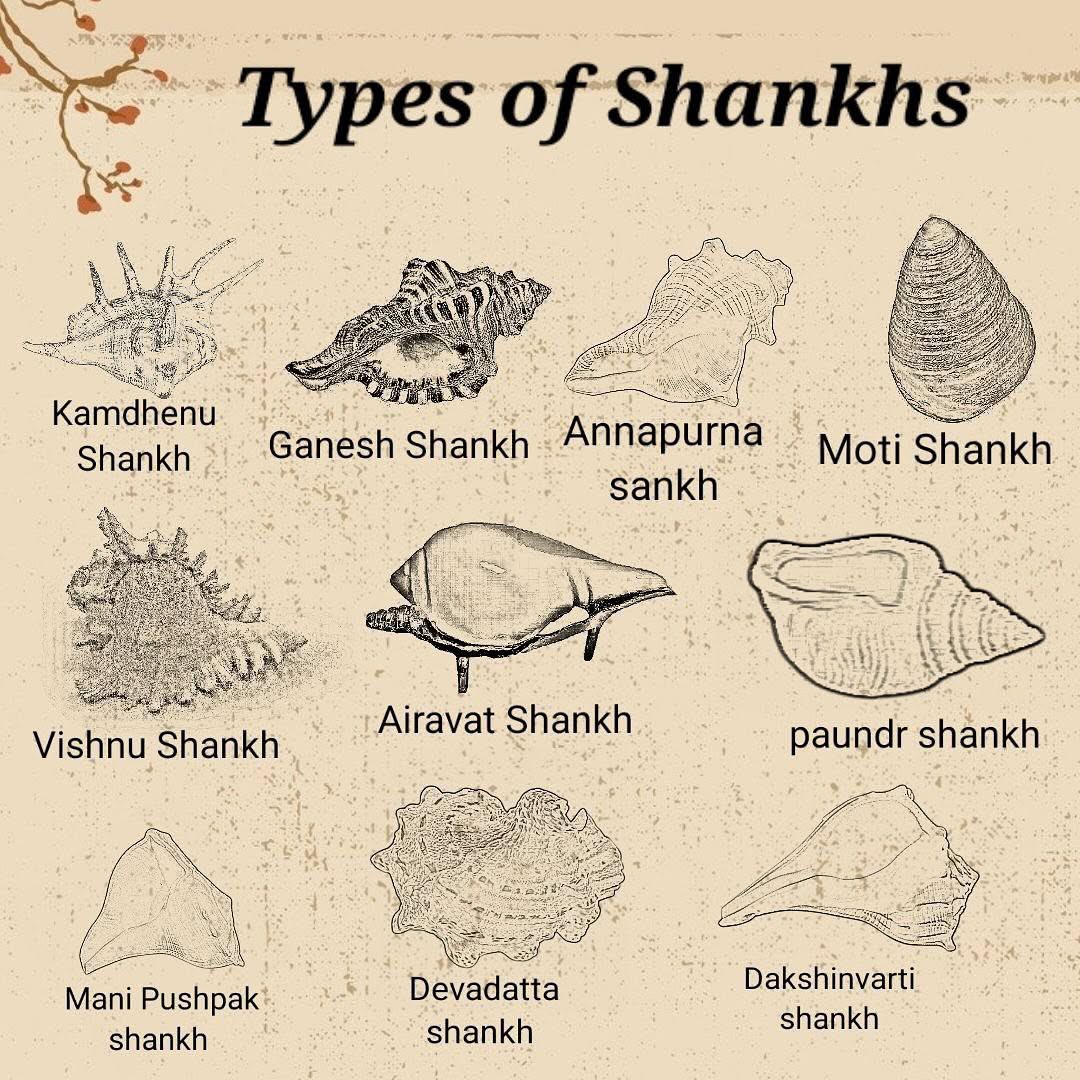In Hinduism, the shankh (Sanskrit: शंख, meaning “conch”) holds a revered place as a sacred object deeply embedded in religious rituals, mythology, and spiritual practices. Often associated with divine beings like Bhagwan Vishnu, the shankh is not just a natural conch shell but a symbol of purity, prosperity, and the cosmic sound of creation. This article explores the various types of shankhs, their significance, and their role in Hindu traditions, drawing from a detailed thread on X by @photosamaz as well as other credible sources.
What is a Shankh?
A shankh is a conch shell, typically from the species of large sea snails like Turbinella pyrum, found in the Indian Ocean. Its physical characteristics include a hard, brittle, and translucent surface with a hollow interior. The inner surfaces are often shiny, while the outer surface may exhibit tuberculation (small, bumpy projections). In Hinduism, the most sought-after shankhs are shiny, white, soft, and heavy, with pointed ends, symbolizing purity and divinity.
The shankh has been used in Hindu rituals for centuries, both as a ceremonial object and as a trumpet, producing a resonant sound believed to purify the environment and invoke divine energies. Its significance is deeply rooted in Hindu mythology, where it is often associated with gods like Vishnu, Lakshmi, and other deities.
Types of Shankhs
The X thread by @photosamaz provides a beautifully illustrated guide to various types of shankhs, each with unique characteristics and spiritual significance. Below is a detailed breakdown of the ten types mentioned in the thread (Credits for images – X thread mentioned earlier), along with additional context from other sources:
- Kamdhenu Shankh
Also known as the “Kamdhenu Conch,” this shankh is believed to resemble the mouth of the mythical Kamdhenu cow, a wish-granting creature in Hindu mythology. It is considered a symbol of prosperity and wish-fulfillment, often used in rituals to invoke abundance. The Kamdhenu is also linked to the cosmic churning of the ocean (Samudra Manthan), where it emerged as a divine gift.
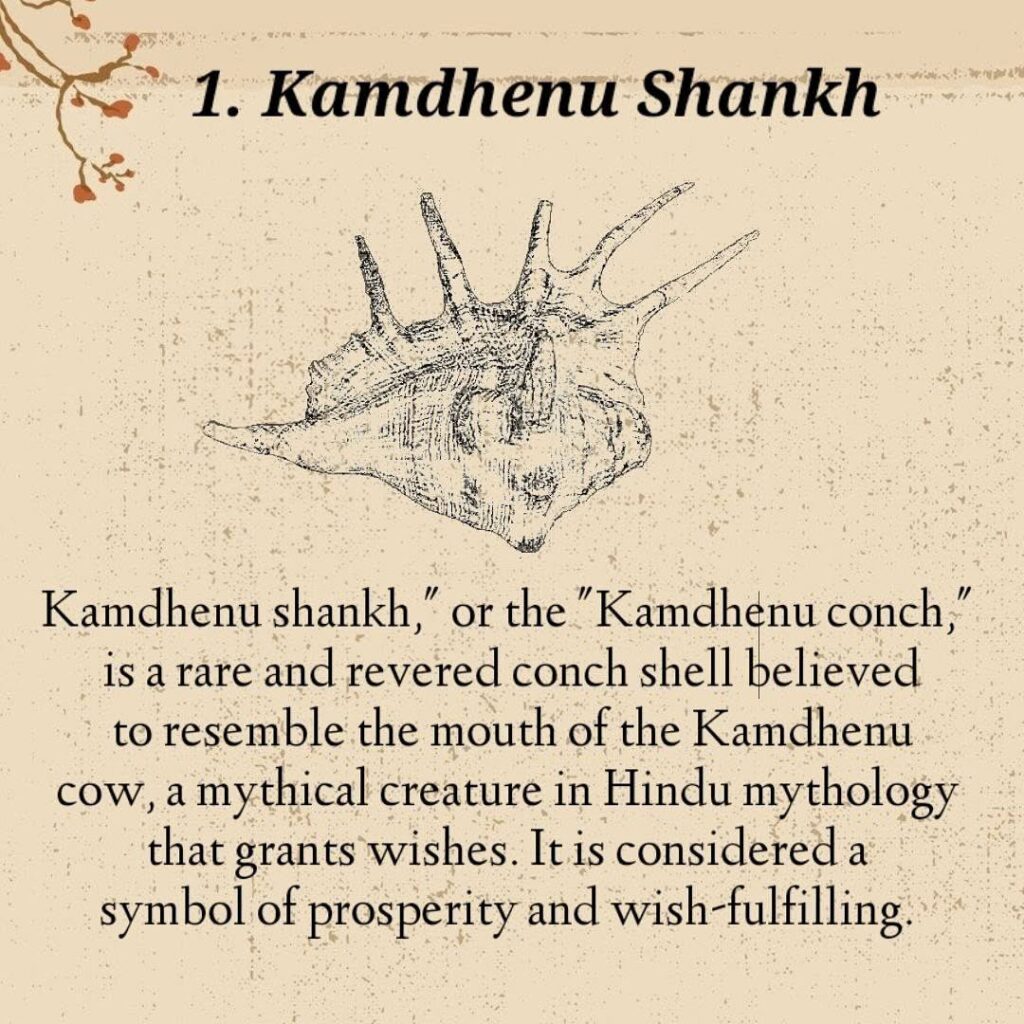
- Ganesh Shankh
Named after Bhagwan Ganesha, the remover of obstacles, this shankh’s shape is said to resemble the deity’s form. Worshipping the Ganesh Shankh is believed to bring progress in all spheres of life, dispel negative energies, and spread positivity. It is a rare variety found only in the Indian Ocean, making it highly prized for spiritual practices.

- Annapurna Shankh
Also called the “Pink Conch,” the Annapurna Shankh is associated with Goddess Annapurna, the deity of food and nourishment. It symbolizes abundance and prosperity and is valued for its soft, soothing sound, often used in rituals to invoke blessings for sustenance and well-being.
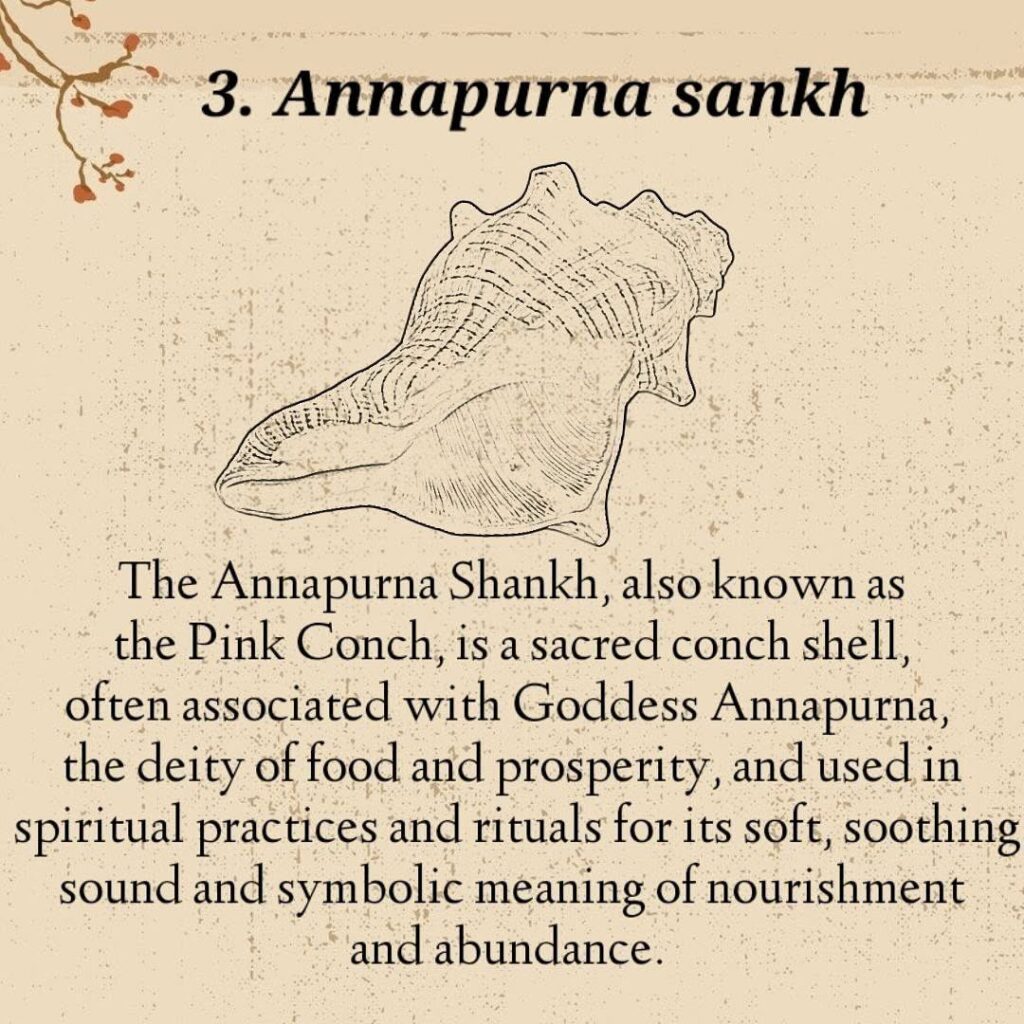
- Moti Shankh
Known as the “Pearl Conch,” the Moti Shankh is a sacred shell revered for symbolizing good fortune and prosperity. It is often used in religious ceremonies and meditation practices, believed to bring peace and spiritual growth to the practitioner.
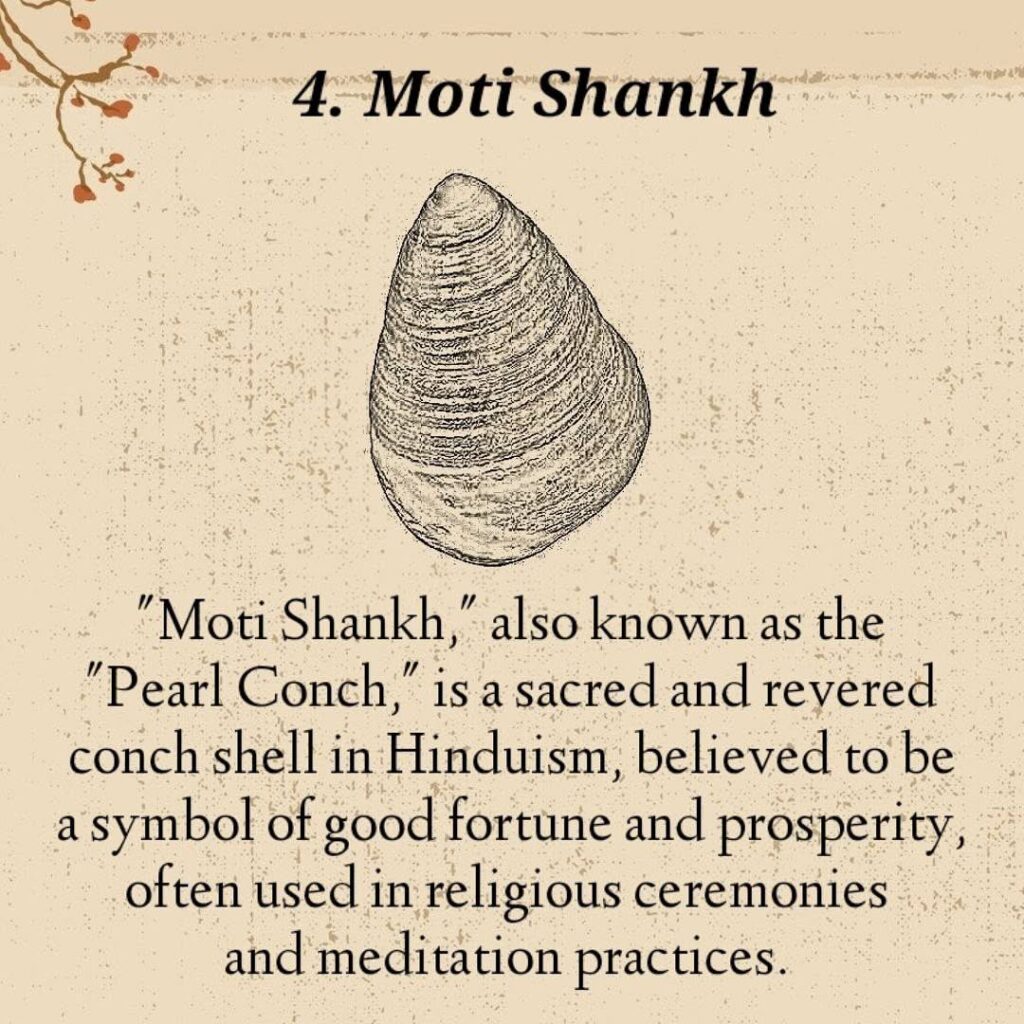
- Vishnu Shankh
Also referred to as Panchajanya or Suryamukhi Shankh, this shankh is sacred to Bhagwan Vishnu, the preserver deity in Hinduism. It symbolizes divine power, purity, and the sound of creation. Historically, it was used as a war trumpet, as seen in the Mahabharata, where it was blown to signal the start of battles. In rituals, its sound is believed to ward off evil spirits.
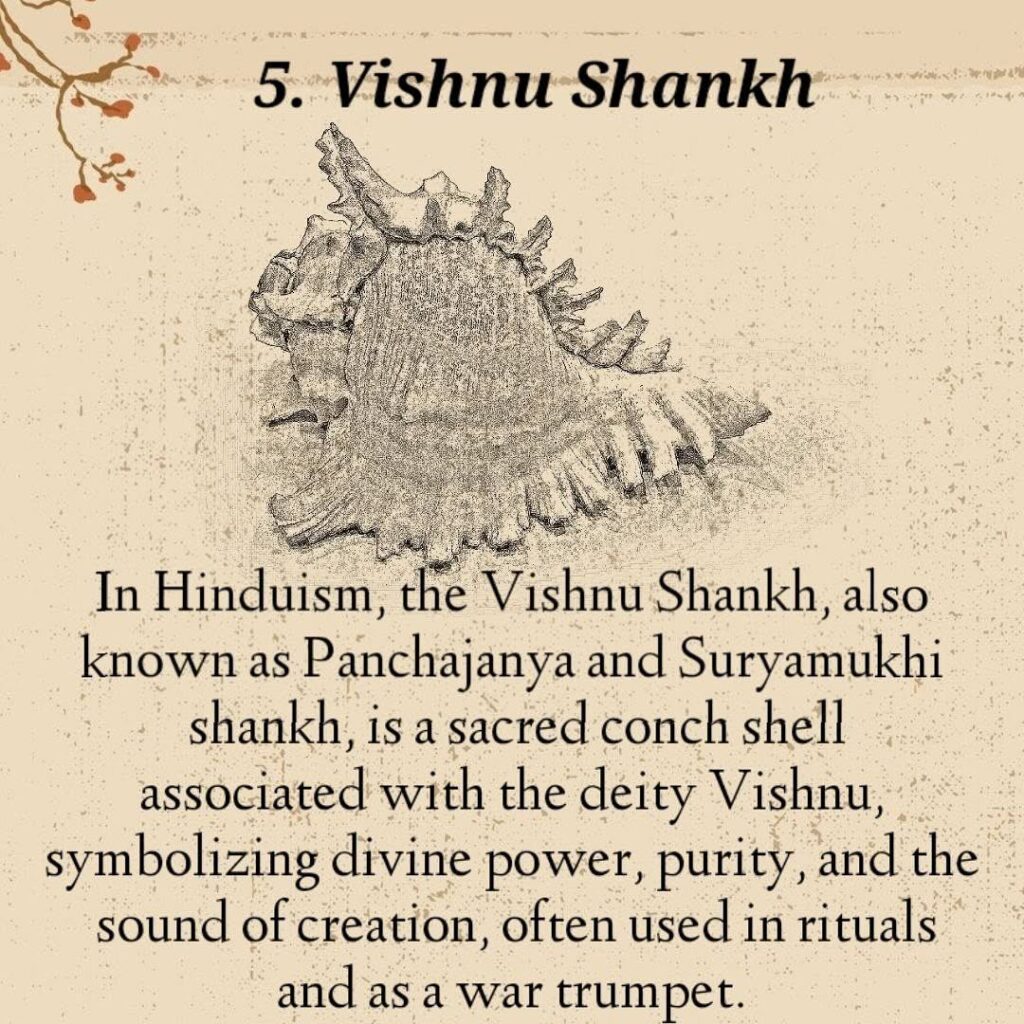
- Airavat Shankh
Named after Airavata, the mythical white elephant of Indra, this shankh is associated with strength and divine protection. It is often used in rituals to invoke blessings for courage and stability.
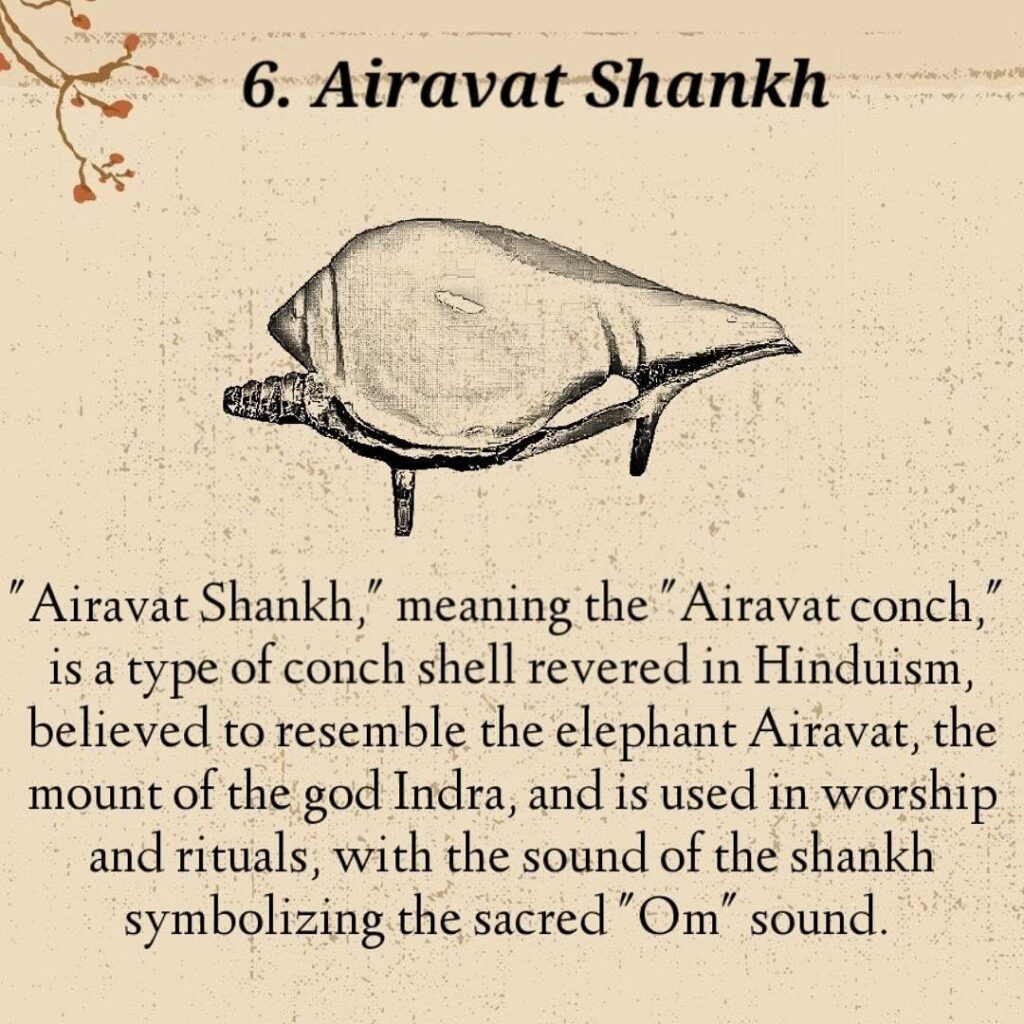
- Paundra Shankh
This shankh is linked to the Mahabharata and is believed to have been used by Bhima, one of the Pandava brothers. It symbolizes power and valor, often blown during ceremonies to invoke strength and victory.
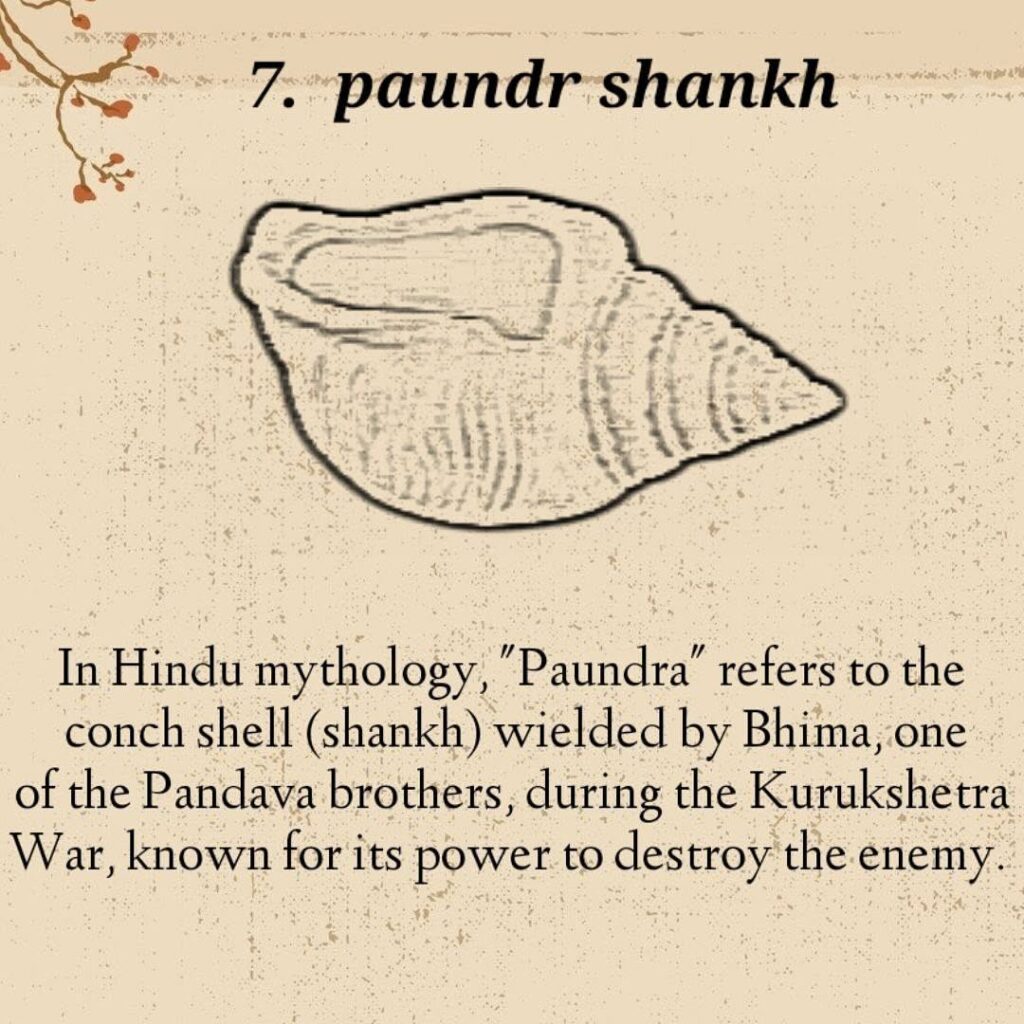
- Mani Pushpak Shankh
Another shankh tied to the Mahabharata, the Mani Pushpak Shankh is associated with divine energy and spiritual elevation. It is believed to enhance the spiritual atmosphere during worship.

- Devadatta Shankh
The Devadatta Shankh is the divine conch of Arjuna, another Pandava brother, gifted by the gods. It is known for its powerful, resonant sound, symbolizing divine authority and courage in battle. In rituals, it is used to invoke divine blessings for strength and success.
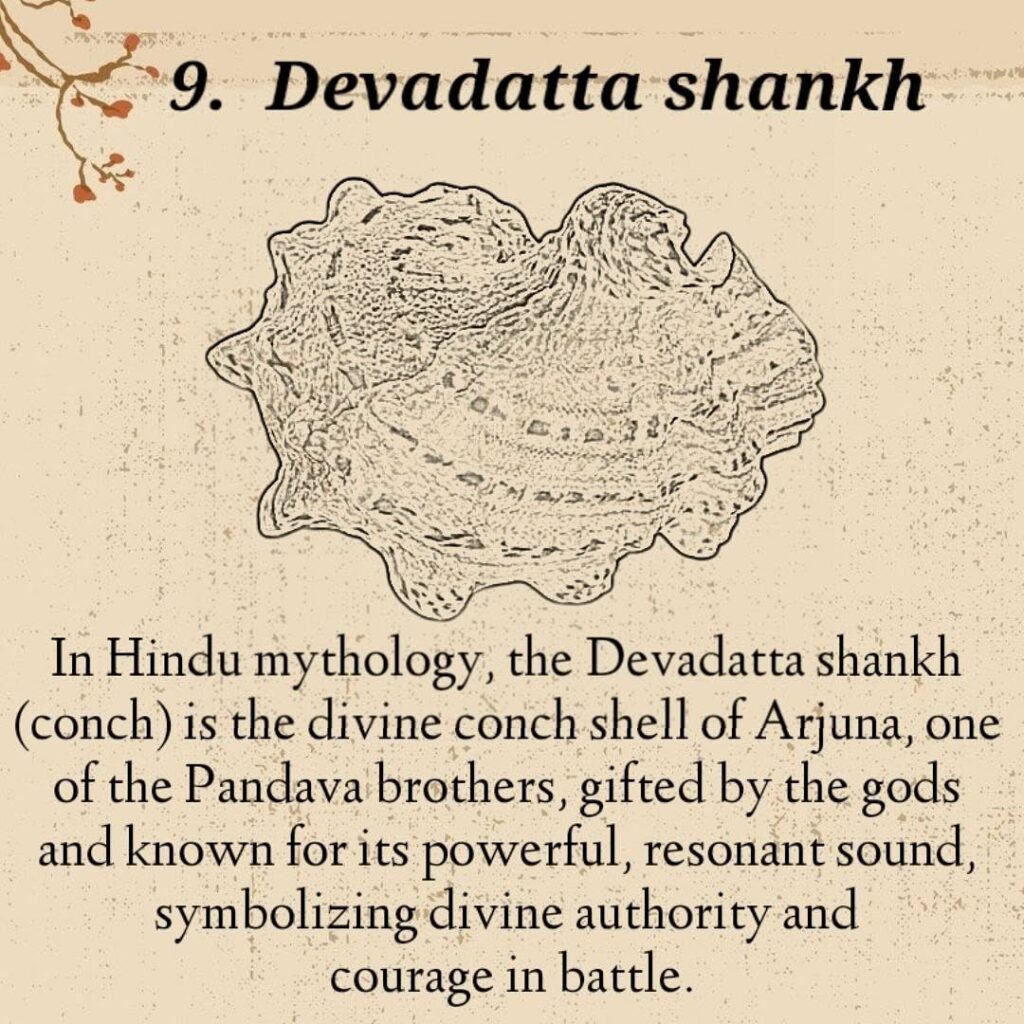
- Dakshinavarti Shankh
Translating to “right-handed conch shell,” the Dakshinavarti Shankh is a rare variety with a right-handed spiral, associated with Goddess Lakshmi, the deity of wealth and prosperity. It is believed to be her abode and is highly auspicious for bringing wealth, removing negativity, and aiding meditation. This type is particularly valued for its medicinal and spiritual uses and is found in the Indian Ocean.
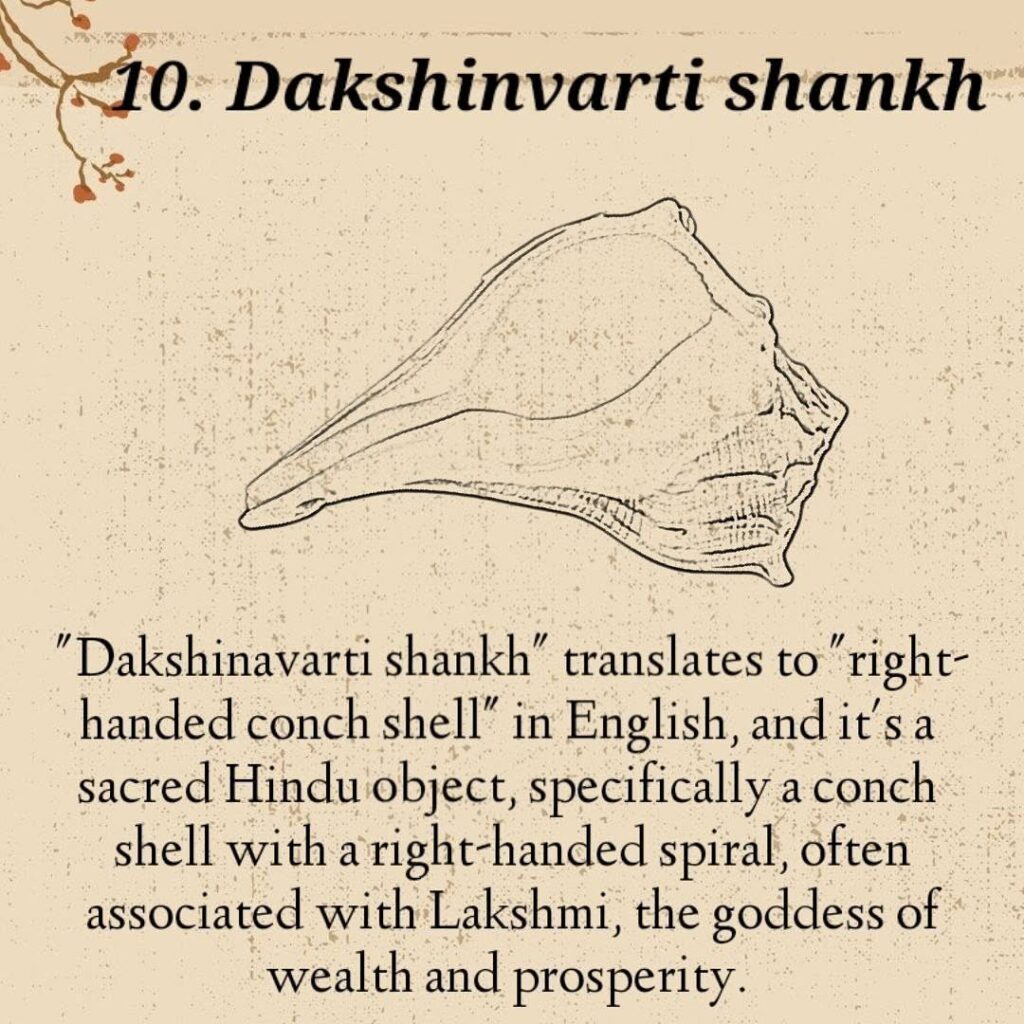
Additionally, shankhs are classified based on their coiling direction:
- Vamavarta Shankh (“left-turned”): This is the more common variety, with a dextral (clockwise) spiral when viewed from the apex.
- Dakshinavarti Shankh (“right-turned”): A rarer and more auspicious type, with a right-handed spiral, symbolizing infinite space and associated with Vishnu and Lakshmi.
Importance and Significance in Hinduism
The shankh holds immense spiritual and cultural significance in Hinduism, serving as both a ritualistic tool and a symbol of divine energy. Here are some key aspects of its importance:
1. Association with Deities
The shankh is most prominently linked to Bhagwan Vishnu, whose sacred conch, Panchajanya, is a symbol of his divine authority. It is said to represent the sound of creation and the preservation of the universe. The Dakshinavarti Shankh, in particular, is believed to be the abode of Goddess Lakshmi, bringing wealth and prosperity to those who worship it.
Other deities, such as Ganesha, Annapurna, and the Pandava brothers, are also associated with specific shankhs, each carrying unique blessings related to their divine domains.
2. Ritualistic Use
The shankh is an integral part of Hindu rituals, blown to mark the beginning of ceremonies, pujas, and other sacred events. Its sound is believed to:
- Purify the environment by dispelling negative energies.
- Invoke divine blessings and create a spiritual atmosphere.
- Aid in meditation by providing a calming, resonant sound that helps focus the mind.
Historically, the shankh was also used as a war trumpet, as seen in the Mahabharata, where warriors like Arjuna and Bhima blew their conches (Devadatta and Paundra, respectively) to signal the start of battle.
3. Symbolism
The shankh embodies several profound spiritual concepts:
- Sound of Creation: The sound of the shankh is said to represent the primordial sound “Om,” the vibration from which the universe emerged.
- Purity and Divinity: Its white, shiny appearance symbolizes purity and divine energy.
- Prosperity and Abundance: Especially with the Dakshinavarti Shankh, the conch is a symbol of wealth and good fortune, often used in rituals to attract prosperity.
Pauranic History Origins
In Hindu Pauranic History, the shankh emerged during the Samudra Manthan (churning of the cosmic ocean), a significant event where gods and demons collaborated to obtain amrit (nectar of immortality). Bhagwan Dhanvantari, the god of Ayurveda, rose from the ocean holding divine objects, including the shankh, symbolizing its celestial origins.
The Kamdhenu Shankh, for instance, is linked to the wish-granting cow Kamdhenu, which also emerged during this event, further tying the shankh to abundance and divine blessings.
Spiritual and Practical Benefits
- Removes Negativity: The sound of the shankh is believed to purify the surroundings, making it a popular tool for cleansing spaces during worship.
- Aids Meditation: The resonant sound helps practitioners focus and deepen their meditative state.
- Brings Prosperity: Keeping a Dakshinavarti Shankh at home is thought to attract wealth and blessings, especially due to its association with Lakshmi.
Cultural and Spiritual Legacy
The shankh is not just a ritual object but a cultural artifact that reflects the deep spiritual heritage of Hinduism. It bridges the material and the divine, serving as a reminder of the cosmic order and the presence of divine energies in everyday life. As noted in a blog dedicated to Indian mythology, discussing such symbols helps preserve cultural traditions and fosters an optimistic understanding of existence.
The Dakshinavarti Shankh, with its rarity and auspiciousness, is particularly cherished, often passed down through generations as a family heirloom. Its use in worship, meditation, and other spiritual practices underscores its role as a conduit for divine blessings.
Health Benefits of Playing the Shankh: Enhancing Lungs and Breathing
Blowing the shankh, known as Shankhnaad, offers significant health benefits, particularly for the respiratory system. The act requires deep inhalation through the nose and controlled exhalation through the mouth, which strengthens lung capacity and improves respiratory function. Modern scientific research, such as studies published in the Asian Pacific Journal of Health Sciences, highlights that regular shankh blowing can reduce blockages in the heart, enhance exhalation strength, and aid in clearing the respiratory tract, benefiting individuals with conditions like asthma or pulmonary disorders. Additionally, the practice stimulates the parasympathetic nervous system, reducing stress and promoting mental relaxation, which further supports efficient breathing.
Conclusion
The shankh, in its many forms, is a powerful symbol in Hinduism, embodying the sacred sound of creation, divine protection, prosperity, and health. From the wish-granting Kamdhenu Shankh to the wealth-attracting Dakshinavarti Shankh, each type carries unique significance, reflecting the diversity of Hindu spiritual practices. Beyond its spiritual role, blowing the shankh offers scientifically backed benefits for lung health and breathing, making it a holistic tool for both physical and spiritual well-being. Whether blown during a puja, placed on an altar, or used in meditation, the shankh continues to be a cherished object, connecting devotees to the divine while promoting overall wellness and preserving the rich tapestry of Hindu mythology and tradition.

